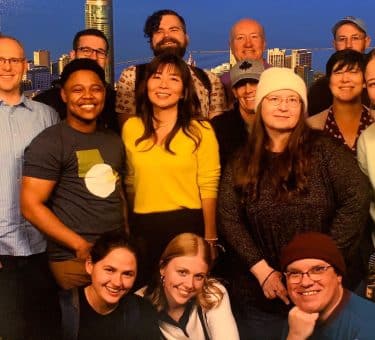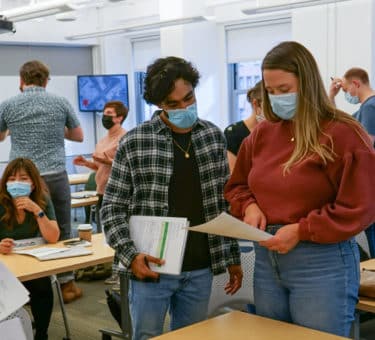Do you miss recess? I do.
What your grade school teachers never told you was that recess wasn’t just a break from schoolwork — the unstructured playtime actually helped your cognitive development. Research has shown that creative playtime is beneficial at any age and should still be incorporated into your life today. At Tandem, we’ve been doing monthly creative exercises to create space for regular playtime with our remote team, and we’d love to share why.

The Benefits of Creative Play
You may be thinking, “Recess was fun and all, but that’s for kids, right? We have work to get done!” However, playtime has immediate physical and mental benefits and increases creativity, productivity, and group cohesion in the workplace. It helps our minds and bodies and, in turn, helps our work.
Creative play can lower stress by reducing cortisol levels and releasing endorphins and has even been found to facilitate insight ability and divergent thinking. Many Tandemites have expressed that having creative exercise time in the middle of the day is something they look forward to and gets them thinking in new ways. “I have more energy going back into [my client project] after a creative exercise. Everybody has so many great ideas; it makes me believe there is a solution to whatever I’m working on next,” says designer McKenzie Landorf.
Regular creative activities have been shown to keep depression at bay and lower the risk of dementia. So not only are we having fun, but we are keeping our minds sharp.
How to Create Space for Beneficial Play
To access the benefits of play, our minds need to be relaxed, open, and in the moment. An ideal play experience is similar to a flow state: we lose track of time, feel energized, and become fully involved, just like recess all those years ago.
To enter this mindset there are two key factors: the activity must be voluntary, and it must be done for fun with no outcomes or expected results. In our creative exercises at Tandem, we encourage participants to share pictures of what they made during the activity, but only if they feel comfortable doing so. The activities are always optional, and for those who join, there is no obligation to turn on their webcam.
It is very tempting to tie group activities to specific outcomes or “getting stuff done,” but avoiding this urge is important. At first, your team may struggle with the idea of play not meeting any organizational objectives, but with time and practice, it will feel more natural to them.
Structured Un-Work
It is crucial that play activities strike a balance between structure and open exploration. An activity without structure or guidance can lead to participants not knowing where to start and becoming disengaged. On the other hand, an exercise that is too tightly structured leaves no room for playful creativity.
For example, we were recently planning a creative painting activity and had mailed painting kits to each team member. If we had told participants, ”Go ahead and make a painting,” many of them may not have known where to start — especially if they didn’t have much experience with painting. But if we had guided them through a step-by-step activity to faithfully recreate a famous painting, there would have been little room for creativity and play.
Instead, Tandem designer Jewel Tolbert led us in a still-life painting activity, balancing the line between structured and unstructured play. Each of us gathered objects in our vicinity, arranged them, and made a painting where each object had a different base color. It had enough structure that we knew what to do but left many of the creative choices up to us to play with.
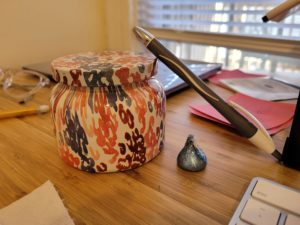

Our 3-color still life painting exercise aimed at finding a balance between structured activity and open-ended exploration (painting by Anna Wolf).
Play & Mindfulness
Ensuring that our creative exercises are hands-on is an important part of our planning process. Thinking with your hands during creative play helps you be in the moment, not thinking about what comes next. This is a form of mindfulness, which has been widely recommended as a healthy practice that reduces stress and anxiety.
Working with your hands helps your brain work differently, sparking insight and innovation. Another benefit of using your hands to make things is getting a break from screens, as prolonged screen time can cause eye strain and decreased productivity.
We’ve also learned to embrace silence during creative exercises. Even though we are all connected through a video or audio call, no one is talking most of the time. Instead, we’re all focused on what we’re making with our hands. Encouraging silence on a video call reinforces the idea that we are doing this together and creates a shared experience while still allowing us to lose ourselves in play.
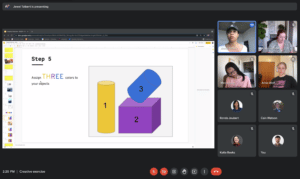
Jewel guides us in a still-life painting activity while we make paintings at our work spaces.
Group Cohesion
When working remotely, it can be particularly challenging to create space to connect and bond with teammates you may not work with daily. We’ve found that the shared experience of creative exercises can be a healthy and genuine way to connect. And by sending our teammates supplies that can be used for multiple activities, everyone always has the same context and medium.
McKenzie explains the power of connecting with coworkers through a playful activity. “It’s tough to connect on a more personal level when working remotely. In creative exercises, you can feel the culture of the people you work with. Getting on a call, having almost no agenda — it gives insight into who they are as people and [a way to] see them in a new light.”
We’ve also learned to clearly and consistently promote our creative playtime as something for everyone in the company, not just folks who work in a traditionally “creative” role. For designers, it may be more obvious how creative exercises positively impact their work — but as we’ve explored, the activities are just as valuable for everyone else on the team.
2 Creative Exercises to Get You Started
Collaborative Group Mural: if you have more time to prep
For this activity, facilitated by McKenzie and me, we broke up the Tandem logo into a grid of 30 pieces and asked each participant to make a painting of one of the pieces. The paintings were playful and abstract on their own, and when put together, they created a Tandem mural. A bonus was that each of us got a piece of Tandem to hang on our walls at home. 🙂
More so than other activities, this one took some behind-the-scenes work from our facilitators. We needed to break up the logo into enough pieces for the number of participants and then assign each person a piece to paint. After each participant painted and photographed their piece, we assembled them into a digital mural.
It was important to emphasize that the final output would be messy and chaotic, and that’s okay. The risk with this activity is participants feeling like they need to do a perfect job of recreating the shape on their piece. They don’t need to be perfect! The charm is in the imperfections.
Materials needed
- Open table space to work
- Newspaper, mat, or other loose paper to protect your table or desk
- An old shirt or smock/apron if you want to protect your clothes
- Paint kit (we mailed these to each team member)
- Cup of water for your paintbrushes
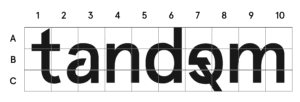

The grid we used to assign pieces to participants (above) and the finished mural (below).
Letter Photography: if you have less time to prep
Also letter-themed, this activity requires very little prep time and has the added benefit of getting participants outside.
For this activity, facilitated by Jewel, we simply asked participants to go outside and take pictures of each letter in their name. The catch was that you couldn’t photograph any actual typography — each photo had to be a shape or group of shapes that you thought looked like a letter. Afterward, we spelled out our names with the photos and shared them in Slack.
It was a really engaging exercise that got us outside, away from our computers, carefully observing our surroundings, and seeing everyday things in new ways. I came back to my desk energized and inspired.
Materials needed
- A camera or smartphone


“Elizabeth” and “Chris” spelled out in shapes found outside (photos by Elizabeth Coleman and Chris Coffin).
Do you want to work on a team that values creativity in every role? Visit our Careers page to apply for an open role!






